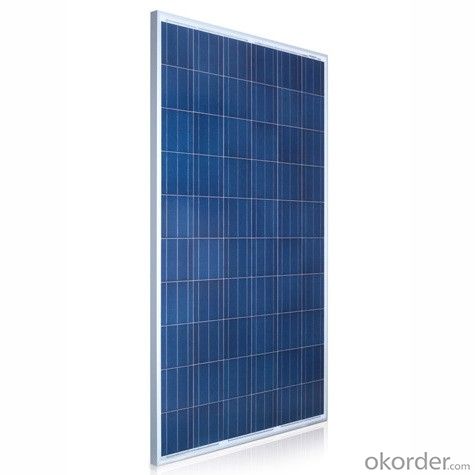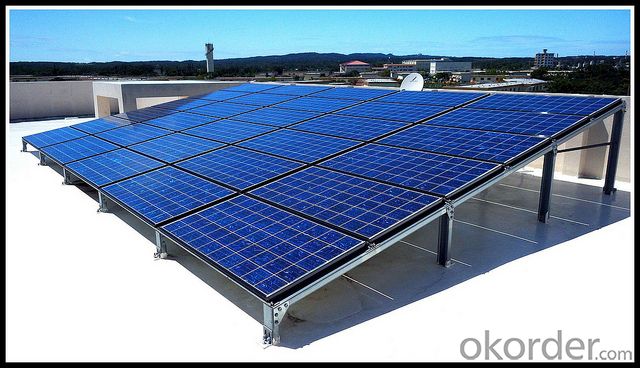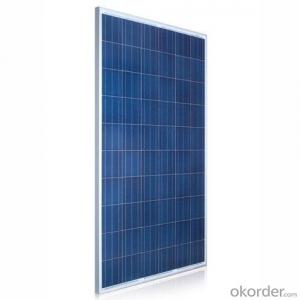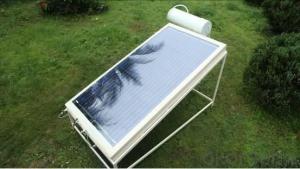0.45W Poly solar Panel with Factory Directly Sale CNBM
- Loading Port:
- Qingdao
- Payment Terms:
- TT OR LC
- Min Order Qty:
- 10 set
- Supply Capability:
- 300000 set/month
OKorder Service Pledge
OKorder Financial Service
You Might Also Like
Polycrystalline Solar Modules
CNBM offers a range of small, medium and large polycrystalline solar modules, designed for a range of requirements.
Specifications:
Tolerance | +/-3% |
Cell | Polycrystalline silicon solar cells (156 x 156mm) |
N0. of Cells | 60 (10 x 6) |
Dimension of Modules (mm) | 1650 x 990 x 40 |
Weight (kg) | 25.5 |


Limits:
Operating Temperature | -40~+85? |
Storage Temperature | -40~+85? |
Maximum System Voltage | 1000 VDC max. |
Hail Impact | Diameter of 28mm with impact speed |
Temperature and Coefficients:
NOCT | 48C+/-2? |
Voltage temperature coefficient (%/K) | -0.35 |
Current temperature coefficient (%/K) | 0.05 |
Power temperature coefficient (%/K) | -0.45 |
Characteristics:
Model: | SGM-200P | SGM-210P | SGM-220P |
Max-power voltage Vmp (V) | 29.2 | 29.4 | 29.41 |
Max-power current Imp (A) | 6.85 | 7.14 | 7.48 |
Open-circuit voltage Voc (V) | 36.5 | 36.69 | 36.9 |
Short-Circuit Current Isc (A) | 7.28 | 7.6 | 7.93 |
Max-power Pm(W) | 200 | 210 | 220 |
Model: | SGM-230P |
Max-power voltage Vmp (V) | 29.8 |
Max-power current Imp (A) | 7.72 |
Open-circuit voltage Voc (V) | 37.31 |
Short-Circuit Current Isc (A) | 8.19 |
Max-power Pm(W) | 230 |
STC: Irradiance 1000W/m2, module temperature 25?, AM-=1.5
Poly Crystalline Solar Panels Specifications Range
Maximum Power (Pm) | Dimension | Weight | Operating Voltage (Vmp) | Operating Current (Imp) | Open Circuit Voltage (Voc) | Short Circuit Current (Isc) |
0.45W | 140x80x10mm | 0.08kg | 3.3V | 150mA | 4.6V | 160mA |
1.0W | 162x140x10mm | 0.16kg | 7.5V | 150mA | 10.3V | 160mA |
4.5W | 269x251x23mm | 0.8kg | 16.5V | 0.27A | 20.5V | 0.3A |
10W | 420.1×268.9×22.6mm | 1.92kg | 17.5V | 0.58A | 20.5V | 0.6A |
20W | 425x502x50mm | 3.0kg | 16.8V | 1.19A | 21.0V | 1.29A |
30W | 593x502x22.6mm | 3.9kg | 16.8V | 1.78A | 21.0V | 1.94A |
40W | 655x537x50mm | 5.75kg | 17.3V | 2.31A | 22.1V | 2.54A |
50W | 839x537x50mm | 6.0kg | 17.5V | 2.9A | 21.8V | 3.17A |
65W | 1111x502x50mm | 7.2kg | 17.6V | 3.69A | 22.1V | 3.99A |
80W | 1204x537x50mm | 7.7kg | 17.6V | 4.55A | 22.1V | 4.8A |
- Q:What is the role of anti-reflective coatings in solar cells?
- The role of anti-reflective coatings in solar cells is to minimize the reflection of sunlight off the surface of the solar cell, allowing more light to be absorbed and converted into electricity. This improves the overall efficiency and performance of the solar cell.
- Q:Can solar cells be used for powering outdoor signage?
- Yes, solar cells can be used for powering outdoor signage. Solar panels can convert sunlight into electricity, which can then be used to power various devices including outdoor signage. This is a sustainable and environmentally friendly option, as it reduces dependence on traditional electricity sources and helps to minimize carbon emissions.
- Q:Can solar cells be used for outdoor signage?
- Yes, solar cells can be used for outdoor signage. Solar cells can convert sunlight into electricity, which can power the lighting or display systems used in outdoor signage. This eliminates the need for grid electricity, reducing costs and making outdoor signage more sustainable and environmentally friendly.
- Q:How do solar cells affect the electric grid?
- Solar cells can have a significant impact on the electric grid by generating clean and renewable energy. When connected to the grid, solar cells produce electricity during the day, reducing the overall demand for power from traditional sources. This reduces the strain on the grid and decreases the need for fossil fuel-based power plants. Additionally, excess solar energy generated by these cells can be fed back into the grid, providing a source of power for others and contributing to a more resilient and sustainable energy system.
- Q:Can solar cells be used on satellites?
- Yes, solar cells can be and are commonly used on satellites as their primary source of power. Solar cells convert sunlight into electricity, providing a reliable and renewable source of energy for satellites in orbit around the Earth.
- Q:How do solar cells handle electrical noise or interference?
- Solar cells do not directly handle electrical noise or interference. However, solar cell systems often include components such as inverters or power conditioning units that help mitigate electrical noise or interference by converting the direct current (DC) produced by the solar cells into alternating current (AC) that is more resistant to noise. Additionally, proper grounding and shielding techniques can be employed to minimize any potential interference from external sources.
- Q:What is the role of solar cells in powering off-grid cabins?
- Solar cells play a crucial role in powering off-grid cabins by harnessing sunlight and converting it into electricity. These cells, also known as photovoltaic cells, generate renewable energy that can be stored in batteries for later use. This sustainable power source eliminates the need for traditional electricity grids, allowing off-grid cabins to be completely self-sufficient.
- Q:Is a solar cell expensive to make?
- Not all all.
- Q:Can solar cells be used in desert environments?
- Yes, solar cells can definitely be used in desert environments. In fact, solar energy is particularly well-suited for such locations due to the high levels of solar radiation and clear skies typically found in deserts. The arid climate and ample sunlight make desert regions ideal for harnessing solar power, allowing solar cells to generate a significant amount of electricity.
- Q:How do solar cells impact energy consumption patterns?
- Solar cells impact energy consumption patterns by providing a renewable and clean source of electricity. They reduce reliance on traditional fossil fuels, decrease greenhouse gas emissions, and promote sustainable energy practices. Solar cells enable individuals, businesses, and communities to generate their own power, leading to a more decentralized and resilient energy system. Additionally, solar energy contributes to a more balanced and diversified energy mix, reducing the strain on conventional power grids and enhancing energy security.
1. Manufacturer Overview |
|
|---|---|
| Location | |
| Year Established | |
| Annual Output Value | |
| Main Markets | |
| Company Certifications | |
2. Manufacturer Certificates |
|
|---|---|
| a) Certification Name | |
| Range | |
| Reference | |
| Validity Period | |
3. Manufacturer Capability |
|
|---|---|
| a)Trade Capacity | |
| Nearest Port | |
| Export Percentage | |
| No.of Employees in Trade Department | |
| Language Spoken: | |
| b)Factory Information | |
| Factory Size: | |
| No. of Production Lines | |
| Contract Manufacturing | |
| Product Price Range | |
Send your message to us
0.45W Poly solar Panel with Factory Directly Sale CNBM
- Loading Port:
- Qingdao
- Payment Terms:
- TT OR LC
- Min Order Qty:
- 10 set
- Supply Capability:
- 300000 set/month
OKorder Service Pledge
OKorder Financial Service
Similar products
New products
Hot products
Hot Searches
Related keywords





























